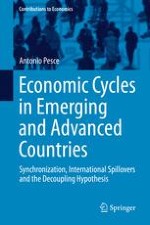2015 | OriginalPaper | Chapter
2. The Decoupling of Emerging Economies, A Long-Debated Issue but Still an Open Question: A Survey
Author : Antonio Pesce
Published in: Economic Cycles in Emerging and Advanced Countries
Publisher: Springer International Publishing
Activate our intelligent search to find suitable subject content or patents.
Select sections of text to find matching patents with Artificial Intelligence. powered by
Select sections of text to find additional relevant content using AI-assisted search. powered by
